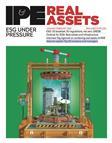It is interesting that an investment tool that brings so much to the management of a real estate portfolio can be so misunderstood. Thanks to the efforts of a number of industry leaders things are changing, and a new initiative brings further hope. Gary McNamara reports
History has shown that all markets tend to ‘overshoot' for one reason or another, but this irrational conduct drives prices beyond or below ‘fair value', and in turn compels investors to use all available means to find that ‘sweet spot of timing'. As is currently being witnessed in the property derivatives world, investors can take advantage of the difference between traditional property forecasts and the implied returns of the derivatives market, highlighted by the credit crunch.
Property derivative prices move daily, reflecting the latest news and sentiment from both macro and micro events affecting all financial markets, not just property. As a result, property derivative pricing is becoming widely recognised as one of the leading indicators of the future performance of the property market.
One of the main barriers to entry into the derivatives market has undoubtedly been a lack of understanding. To outsiders, pricing can appear complicated and intimidating. In January, the major market participants got together and changed the way derivative contracts are quoted; as a result they are far more ‘user friendly' and accessible. Previously, LIBOR +/- spread equated to an X% implied return. Now, it is simply: I pay X% per year to receive IPD performance, or vice versa. The figures here show how commercial property derivatives in Europe are structured.
Assuming a credit line is in place with a bank, the price of a £10m (€12.6m) December 2008 UK IPD All Property swap is -12%. If you think the performance of the IPD UK All Property Index is going to be better than -12%, then you buy it. If you think it is going to perform worse than -12%, you sell, hence ‘shorting' the property market.
If the result released in February 2009 is -5%, you make 7% of £10m ie, £700,000. Alternatively, if it was -13%, you will have lost 1% ie, £100,000.
These deals are called swaps, because you are swapping a fixed rate (ie, -12%) in return for the performance of the index. When IPD contracts are longer than a year, they are settled annually upon release of the IPD results.
In the majority of countries the benchmark used to trade is compiled by the Investment Property Databank (1) (IPD). The IPD is a credible independent body that provides a number of indices relating to performance of commercial property. There are many indices reflecting the country, sector and sub-sector of the property market.
Market growth
The property derivatives market has continually grown since its first year in 2005. Trading volumes in the UK have increased from £850m in 2005 and £3.9bn in 2006 to £7.2bn in 2007. More recently, trading volumes up until Q1 2008 were £3.7bn, which is encouraging in this period of uncertainty.
In Europe, 2007 trading volumes on the IPD French All Office index was £787m compared with £283m on the German All Property index. Interestingly, the Q1 volumes for 2008 showed an increase in trading in Germany with £119m of trades recorded compared with £116m of trades in France.
To date, the main bulk of trading has been carried out through the major investment banks. A number of them have disclosed significant transactions volumes in both commercial and residential markets.
Many major institutions have been involved in the market to date, including Standard Life, Morley, Quintain, AXA REIM, Scottish Widows, Grosvenor, British Land, Prudential and Threadneedle (2). There are also a number of hedge funds that are active in both commercial and residential property derivatives, and current pricing and volatility make this an interesting space for their skill set.
Last year Morley Fund Management stated that it had traded around £500m up to June 2007 and bought significant volumes in early 2008. More recently Standard Life has reportedly invested £75m in to the UK market via property derivatives (3).
Market performance
Back in March 2007, UK total return forecasts for 2007 were around the 10% level, yet the December 2007 contract was priced pretty conservatively, implying around a 7% total return. It was at around this time that a few leading lights from the property world questioned how long the bull run could go on and with that, derivatives prices started to turn.
By June, the December 2007 contract was trading at about 6.25%. From here the drop was pretty severe. The contract to take the biggest fall was December 2008. The drop off in pricing is shown in figure 1.
With the onset of the credit crunch in Q3 2007, property derivative prices fell again sharply, and many forecasters lowered their expectations for returns for the next three years, although nowhere near the levels that swap prices were implying.
Throughout November and December the national press reported that many funds employed up to 12-month redemption periods on their funds. Couple this with the much publicised short-term liquidity issues in the money markets and it is easy to understand why property derivatives prices continued to slide. Such a bearish press has an immediate impact on property derivative prices, and falls have been registered all the way along the curve, particularly the front two contracts.
After the release of the eagerly anticipated IPD November estimate, several big property funds announced significant reductions in valuations of their portfolios, (New Star and Norwich Union, for example) with more falls likely.
In the UK, December 2007 capital value alone fell 4.13% and for the whole Q4 2007, the capital value fell by 9.96%.
At the end of December and in the first week of January, property swap prices rallied from their lows and there certainly appeared to be some opportunistic buying again, particularly in those contracts maturing in 2010 and 2011. However, with the release of various forecasts predicting a weak December 2007 IPD number, swap prices sold off again. Figure 2 shows what property derivative mid-market prices implied for future calendar years in January 2007 and May 2008:
In Europe, the French All Office index returned 18.16% in 2007. The December 2006 to December 2007 contract was trading at around 18% prior to its release. The German All Property came in at 4.49% total return and the 2007 Swiss All Property saw a total return of 7.12%. Derivative contracts were also trading in both these markets in the build-up to each release at levels close to the actual result. Trading has also been carried out on the Italian IPD index (see figure 3).
Retail was the best performing sector in each country shown with the exception of Ireland and the UK. The UK has led the market correction, with French offices looking to follow according to current derivative pricing. Although Germany and France are the two largest markets in Europe, there has also been trading in Switzerland, and certainly this market is starting to grow and be looked at more and more.
A case for using property derivatives
Since the market's inception, multiple parties have entered into swap transactions for a host of different reasons; the main one has been the ability to lock in total returns without actually having to buy the underlying asset. Alternatively some investors have used derivatives to get quick access to property-based returns or to reflect their view of the market. A typical trade can take place in a matter of seconds, avoiding legal costs, stamp duty, and other factors which can take time. Investment banks have been taking a number of long and short positions in order to satisfy client interest, or alternatively to take on further property risk.
Scottish Widows has used property derivatives to manage its cash position during periods of large cash inflows. Property derivatives enabled the cash to gain property exposure quickly while pursuing direct investment. Standard Life has also used property derivatives to reduce exposure to the UK offices market and gain exposure to the Paris offices market.
IPD property derivatives provide the opportunity of a hedge for property portfolio owners, as well as offering the opportunity to speculatively gain exposure to the market in order to reflect a view. In addition, they enable fund managers to re-weight their portfolios without selling the underlying asset by reducing market exposure to the sector via an IPD derivative.
For many investors benchmarked against IPD, buying UK total return swaps at such low prices guarantees outperformance of the IPD index. Looking at property forecasts, the outlook for 2009 onwards is looking considerably better than that for 2008.
As the market develops further, alternative hedging opportunities will emerge. Real estate companies can hedge property portfolios both in terms of capital value and rental income. On a European level, this will lead to the possibility of a European property fund that is overweight to, for instance, Dublin offices and underweight to Stockholm offices, to sell a swap relating to the performance of Dublin offices and purchase a swap on Stockholm offices. There are such a wide range of possibilities open to investors, and as a result of the continued growth and interest in the market, this can only get bigger.
Advantages of property derivatives
User profiles
To keep the market moving at a steady pace there needs to be increased activity from those with direct property exposure, including property companies, funds and institutions. This will provide further depth to the market. This increased activity will help the market move forward and expand into Europe and beyond.
Below are the profiles of parties that have been either transacting or enquiring about the property derivatives market recently:
Product evolution
As the market has evolved, a number of products have been introduced to the market as alternative methods of gaining synthetic property market exposure.
Structured notes can also be used to repackage the swaps into recognisable fixed income instruments for institutional investors, or for private placements. These take many different forms covering a range of income and capital return profiles in order to suit many different types of investors. The primary advantage of these products is that they can be tailored to suit the end user investment strategy and requirements in terms of gearing and capital protection. Such notes create a synthetic property cash flow to a desired specification.
This continued growth has led to the introduction of a number of new indices, trackers and structured products in order to manage property market exposure without buying or selling the physical product.
There are 22 banks licensed to trade on the IPD index; the pricing and liquidity in the market discussed here is obtained from the active participants trading.
The continued development of the market globally is leading to the development of a very useful tool for those that manage property exposure.
1 See url: www.ipdindex.co.uk
2 & 3 Reuters Real Estate
McNamara is an associate director at DTZ Corporate Finance Ltd






